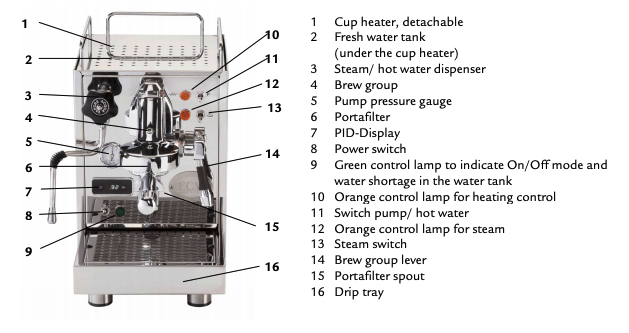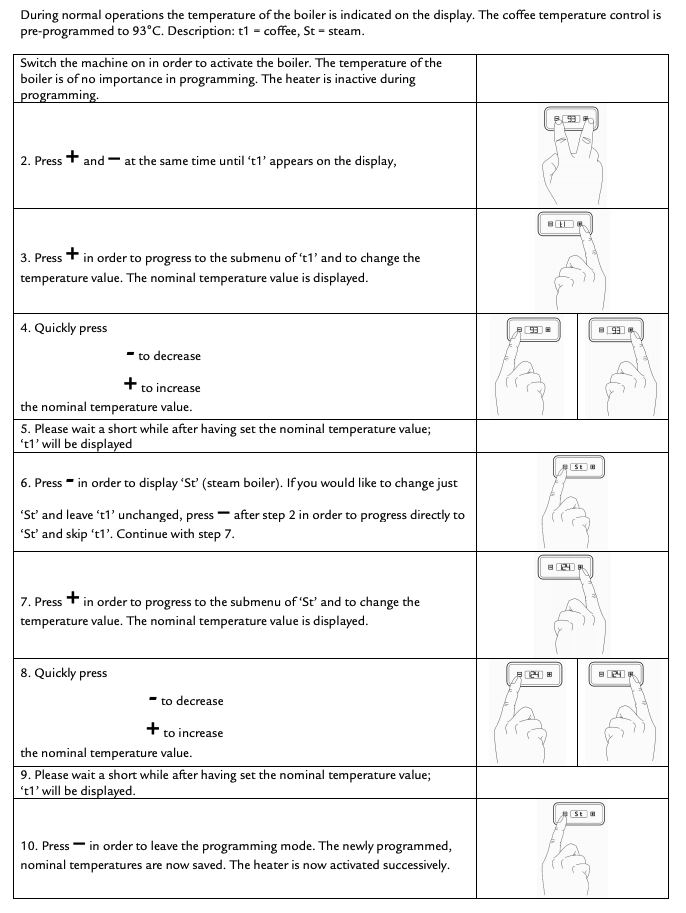ECM Classika: User Manual
Set Up Your ECM Special Edition Classika PID. In this manual, you should find everything you need to operate and maintain your single boiler, E61 espresso machine.
Please read carefully before using your ECM Special Edition Classika PID Espresso Machine.
If you have any other questions, be sure to contact us.
Setup Video
Machine Diagram

Included Accessories
- ECM double spouted portafilter
- ECM bottomless portafilter
- Single basket
- Double basket
- Triple basket
- ECM stainless steel tamper
- Backflush blank
- Grouphead brush
- Water test strip
Water
Espresso machines have specific water requirements. Two primary considerations are filtration and hardness.
Filtration gets rid of tiny particles, such as sand or rust, in your water. If these particles were allowed to enter your machine, they could cause all manner of trouble, particularly by clogging the precise valves and mechanisms in your espresso machine. Almost any water filter will do the job, whether it’s the one built into your fridge, a Brita, or a whole-house filter. Ensuring that this filter is replaced at the proper time will be essential to ensure machine health.
Water hardness is equally important. First, use the water hardness test strips included with your machine to test the water you plan to use with your machine. Ideally, we want a hardness of between 35-85 ppm (parts per million). Hardness refers to the dissolved solids in your water. Common dissolved solids are things like magnesium, calcium, and various forms of sodium. These dissolved solids are what make water, and therefore espresso, taste good. But too much will result in scale buildup in your machine. Scale can cause irreparable damage to your machine by clogging and forming a mineralized layer over the surface of metal parts. The process of descaling is even more damaging, eating away at the machine's metal internals. Luckily, scale can be entirely avoided by keeping your water hardness within the recommended TDS range of 35-85 ppm.
There are numerous methods to soften your water should its dissolved solid content be too high.
A note on RO (Reverse Osmosis) or Distilled Water
Taste aside, espresso machines require some mineral content to function properly. Their steam boiler fill probes, in particular, use water's conductivity to detect the water level. With no dissolved solids, they’ll overfill, giving you water instead of steam. You must add some mineral content back in. Our recommendation is Third Wave Water packets, which are designed to offer ideal flavor and to be safe for your machine.
Reservoir Solutions
Our first recommendation is an in-reservoir water softening pouch. They’re affordable, last 4-6 months, and are very effective. Another great option is to use RO water purchased by the gallon in combination with Third Wave Water packets.
No matter what solution you pick, we recommend testing the water coming from your machine’s group head every few months. City water hardness changes seasonally, and softening systems wear out. Routine testing will ensure your machine stays safe.
First-time setup with the reservoir
First, simply fill the reservoir with your filtered and softened water, leaving a few inches at the top to prevent spillage. The reservoir is removable. Ensure that you do not spill water on top of the machine when filling, as this may cause electrical damage. When filling the reservoir, ensure that the magnetic float is in its housing and that the cap of that housing is in place. When inserting the reservoir, ensure that the face of the reservoir with the magnetic water level float housing is facing the front of the machine.
- Place a small container (a steaming pitcher works perfectly) under the machine's steam wand.
- Open the steam wand by locking the joystick to the side in any direction.
- Turn on the machine by flipping the power switch.
- Activate the machine's pump by flipping on the pump switch.
- Once hot water begins to dispense from the steam wand, allow about 20 oz of water to flush out, then turn the pump switch off. This should take about one minute. The boiler is now full.
- Lift the brew lever for 10 seconds to allow a few ounces of water to flush through the group head.
- You've used a lot of water; now is a good time to refill the machine's reservoir. Your machine is now ready to pull shots of espresso.
Steam Mode
Since the Classika PID is a single boiler, it must be switched into steam mode before you can begin steaming.
- With an empty steaming pitcher on hand, turn on the machine's steam mode switch.
- Place the steam pitcher under the steam wand and open it. We'll need to empty most of the water out of the boiler to make room for steam. Leave the steam wand open for 10 seconds, then close it for about 20 seconds.
- Repeat step 2 until you get a consistent stream of steam from the machine's steam wand. You're now ready to steam milk.
Returning to Brew Mode
- With your empty steaming pitcher on hand, flip the steam switch off.
- Place the steaming pitcher below the steam wand and open the steam wand.
- Flip on the machine's pump switch to begin pushing water into the boiler.
- Once you get a constant stream of water from the steam wand, turn off the pump switch and then close the steam wand. Note: Leaving the pump on for an extended period while the steam wand is closed will cause damage to the pump.
- Lift the brew lever for about 10 seconds to flush a few ounces of water through. Your machine is now ready to pull shots.
Warning: Turning Off the Machine
Do not turn the machine off while it is in steam mode. Always return the machine to its brew mode before turning off. Failure to do so will create a strong vacuum within the boiler, causing unnecessary wear on internal parts, which can result in damage NOT covered by warranty.
Programming PID and Settings

Technical Details
For a complete list of technical details, please see the spec table on our product page.
Now you're ready to start pulling shots! Check out our Espresso 101 section to learn about steaming milk, latte art, our suggested starter espresso recipe, grinder dial-in tips and much more.
Looking for Help with Flow Control?
Helpful Links
- Espresso 101
- More on Water and Setup
- Clive Blog
- Espresso Machine Cleaning & Maintenance
- Manufacturer's Manual
Still have questions? Reach out to our coffee experts and technicians.